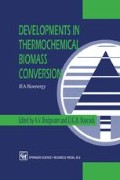Abstract
Coniferous bark, composed of 46,3 wt% carbon, 5,7 wt% hydrogen, 47,2 wt% oxygen and 0,8 wt% nitrogen, was pyroly-zed within a temperature range of 700 to 920 °C. The influence of the process parameters on the product spectrum was investigated. The goal was to receive high amounts of a synthetic gas, aromatics and charcoal. A laboratory size fluidized bed with a capacity of 1 to 5 kg/h was built and used for the continuous process. The main fractions are gases, making up 56 to 62 wt%, and charcoal, affording 17 to 22 wt%.
The gas fraction contains about 49% CO, 27% H2, 15% CH4, and 9% CO2 (in vol.%) and is by this a valuable synthetic gas. The defunctionalisation of liquid wood components (5 wt%) is high; main products are benzene and naphthalene.
The dependence of the product composition on the temperature is not very strong. The amount of CO2 decreases with increasing temperature. The charcoal has a good adsorption quality. The investigations have shown that the pyrolysis of bark, under exclusion of air, in a fluidized bed process is able to produce simple and useful products.
Access this chapter
Tax calculation will be finalised at checkout
Purchases are for personal use only
Preview
Unable to display preview. Download preview PDF.
References
Kaminsky, W. (1985) Recycling of Polymers, J. Anal. Appl. Pyrolysis, No. 8, p. 439.
Kaminsky, W., Schlesselmann, B., and Simon, C. (1995) Olefins from Polyolefins and Mixed Plastics by Pyrolysis, J. Anal. Appl. Pyrolysls, No. 32, p. 19.
Kastner, H., Kaminsky, W. (1995), Recycle Plastics into Feedstocks, Hydrocarbon Processing, No. 74, p. 109.
Kaminsky, W. (1995) Pyrolysis with Respect to Recycling of Polymers, Angew. Makromol. Chem., No 232, p. 151.
Kaminsky, W., and Kummer, A.B. (1989) Fluidized Bed Pyrolysis of Digested Sewage Sludge, J. Anal. Appl. Pyrolysis, No. 16, p. 27.
Kaminsky, W. (1989) Hamburg Leads Sludge to Oil Conversion, World Water, Vol. January, p. 24.
Heinrich, R., Kaminsky, W., and Ying, Y. (1993) Chemicals by Biomass Pyrolysis in a Fluidized Bed, in: Advances in Thermochemical Biomass Conversion, Bridgwater, A.V. (ed.), Blackie Acad. Professional, Cambridge, p. 1222.
Author information
Authors and Affiliations
Editor information
Editors and Affiliations
Rights and permissions
Copyright information
© 1997 Springer Science+Business Media Dordrecht
About this chapter
Cite this chapter
Kaminsky, W., Brolund, N. (1997). Petrochemicals from Bark by Fluidized Bed Pyrolysis. In: Bridgwater, A.V., Boocock, D.G.B. (eds) Developments in Thermochemical Biomass Conversion. Springer, Dordrecht. https://doi.org/10.1007/978-94-009-1559-6_43
Download citation
DOI: https://doi.org/10.1007/978-94-009-1559-6_43
Publisher Name: Springer, Dordrecht
Print ISBN: 978-94-010-7196-3
Online ISBN: 978-94-009-1559-6
eBook Packages: Springer Book Archive

